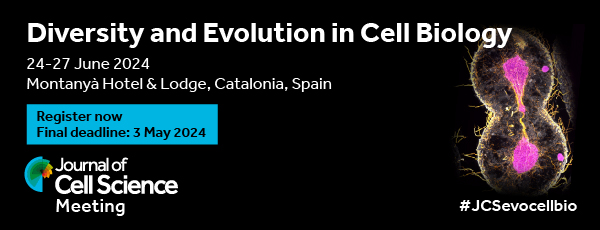Issues
-
Cover image
Cover Image

Cover: Confocal image depicting a SKOR1-mutant triple-negative breast cancer cell. The image has been stylised using the Oil Paint filter in Adobe Photoshop. Focal adhesions and the heart-shaped nucleus are highlighted in red, and the homogenous cytoplasmic distribution of overexpressed mutant SKOR1 is shown in green. SKOR1-mutant cells exhibit a non-invasive phenotype, including extensive cell spreading and abundant focal adhesion sites, which is in clear contrast to the well-known aggressive phenotype of the parental triple-negative breast cancer cells. See article by L. M. Sluimer et al. (jcs260243).
- PDF Icon PDF LinkTable of contents
- PDF Icon PDF LinkIssue info
RESEARCH HIGHLIGHTS
STICKY WICKET
CELL SCIENTISTS TO WATCH
REVIEWS
Ciliary mechanosensation – roles of polycystins and mastigonemes
Summary: Polycystin channels reside on cilia of cells in many important tissues, and polycystin mutations can lead to polycystic kidney disease. Here, we review working models describing ciliary polycystin function.
Structure and function of distal and subdistal appendages of the mother centriole
Summary: A review of the composition and assembly of centriolar appendages, as well as their roles in development and disease.
RESEARCH ARTICLES
DRP1 mutations associated with EMPF1 encephalopathy alter mitochondrial membrane potential and metabolic programs
Highlighted Article: Dominant-negative mutations in DRP1 identified in patients with EMPF1 result in mitochondrial and peroxisomal hyperfusion, severe alterations in mitochondrial membrane potential and metabolic reprograming.
Intravital imaging of Wnt/β-catenin and ATF2-dependent signalling pathways during tumour cell invasion and metastasis
Summary: Using intravital imaging and an avian embryo xenograft model, we show that canonical Wnt and ATF2 signalling pathways have complementary activity patterns during human cancer cell invasion and metastasis.
ULK1-mediated phosphorylation regulates the conserved role of YKT6 in autophagy
Summary: The SNARE protein YKT6 plays a conserved role in autophagosome formation and fusion with lysosomes, which is controlled by the ULK1 kinase.
Lsp1 partially substitutes for Pil1 function in eisosome assembly under stress conditions
Summary: The Pil1 homolog Lsp1 is sufficient for eisosome assembly under various types of membrane stress in yeast. Eisosome assembly is connected to respiration, the TCA cycle, DNA repair, ribosome biogenesis and cell cycle.
The C-terminus of the cargo receptor Erv14 affects COPII vesicle formation and cargo delivery
Summary: COPII vesicle formation and trafficking of plasma membrane proteins depend on the phosphorylated state of S134 in Erv14
SKOR1 mediates FER kinase-dependent invasive growth of breast cancer cells
Summary: Ski family transcriptional corepressor 1 (SKOR1), which has been mainly associated with neuronal development, is a direct substrate of the oncogenic tyrosine kinase FER and a driver of triple-negative breast cancer progression.
Dynamics of intracellular cGMP during chemotaxis in Dictyostelium cells
Highlighted Article: Propagating waves of intracellular cGMP were visualized in chemotactic Dictyostelium cells with a fluorescent probe. Increased intracellular cGMP levels induced a transient shuttle of myosin II between the cytosol and cell cortex.
Diacylglycerol at the inner nuclear membrane fuels nuclear envelope expansion in closed mitosis
Highlighted Article: Mitotic fidelity in the fission yeast S. pombe, which undergoes closed mitosis, requires diacylglycerol consumption fueling a spike in glycerophospholipid biosynthesis to enable nuclear membrane expansion.
CCDC66 regulates primary cilium length and signaling via interactions with transition zone and axonemal proteins
Summary: The primary cilium is a microtubule-based organelle that acts as a signaling nexus. The ciliopathy-linked protein CCDC66 is required for assembling signaling-competent cilia with proper structure and size.
FIRST PERSON
CORRECTION
Introducing our new Editors

We welcome three new Editors to Journal of Cell Science - Robert Parton, Richa Rikhy and Simon Cook. You can read more about them in the Editorial from our Editor-in-Chief Michael Way.
2024 Journal Meeting 'Diversity and Evolution in Cell Biology'

Registration is open for our 2024 Journal Meeting Diversity and Evolution in Cell Biology, which aims to bring together evolutionary biologists and cell biologists investigating diverse aspects of cellular physiology. Final registration deadline: 3 May 2024.
Workshop: Physics of the Early Embryonic Cell Divisions

Early-career researchers interested in the roles of nuclear lipids, apply now for one of the ten funded places at this Workshop, which will take place 11-14 November 2024. Application deadline: 17 May.
Reasons to submit to Journal of Cell Science

There are many benefits to publishing in Journal of Cell Science - read more about why you should choose JCS or visit our submission page now.
Propose a new Workshop for 2026

We are now accepting proposals for our 2026 Workshops programme. We aim to be responsive to the community and open to novel initiatives, so if you have a new idea for a biological workshop that you feel would work well, please apply. Applications deadline: 19 July 2024.



